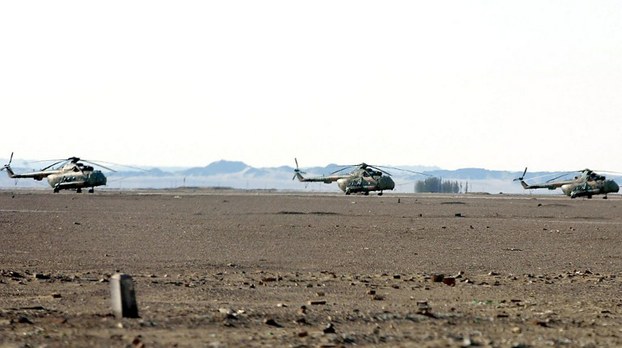| Radio Free Asia |
| August 8, 2014 |
| Washington DC |
 |
|
| Chinese People's Liberation Army airforce helicopters at a military base near the Jiuquan Satellite Launch Base in Inner Mongolia's remote Gobi desert, in a file photo. (AFP) |
Photos posted on China's Twitter-like service Sina Weibo and later deleted showed clouds of orange smoke and pieces of wreckage bearing the logo of China Aerospace.
Local residents and eyewitnesses told RFA the rocket exploded in Arbas subdivision of Otog Banner (or county), in Inner Mongolia's Ordos administrative region.
"I saw it ... the smoke was red and yellow," a local resident named Chagaanbaar told RFA's Mandarin Service after the explosion. "[It crashed] about one kilometer away."
Chagaanbaar said no one had died in the explosion, which hit Bulong Gachaa, a remote and sparsely populated rural area inhabited by traditional herding families.
"We were told we had to leave," Chagaanbaar said, adding that the group of families had relocated to Bulong Lake.
Meanwhile, Inner Mongolia resident Huhe, who posted the photographs, said the rocket had initially been wrongly reported as a missile.
"I wrote the wrong thing in Chinese, but yes, it did come down in that location, and the local authorities have now sealed off the area," Huhe said.
"Neither the police nor the government have given an explanation of what is going on here," he added.
Huhe said the photos were taken by a friend. "I just posted them, and they've already been retweeted more than 1,000 times."
He said the explosion had many witnesses on the ground, as well.
"A lot of people saw it, such a massive impact. It left a huge crater," Huhe added.
He said the authorities had been quick to clear away the wreckage.
"I just made a couple of phone calls, and it turns out they have already taken it away," he said.
"I have sent a number of private messages to a government account on Sina Weibo, but they're just ignoring me, so in the end I posted anyway."
'Secret matter'
An official who answered the phone at the Arbas sub-division government on Thursday declined to comment on the incident.
"This is a secret matter, and we can have nothing to do with it," the official said. "It seems there was [an incident], but you'll have to ask elsewhere."
A duty officer who answered the phone at the Arbas police station gave a similar response.
"We can't let you have any information, because this is a secret matter," he said.
But he confirmed that a clean-up operation had already been carried out. "There is nothing remaining at the scene now," he added.
He said police were "currently looking for the source of the online photographs."
"We are just following orders from higher departments," the officer said.
Meanwhile, an official who answered the phone at the Otog Banner government offices hung up when contacted by RFA.
Nuclear testing
The U.S.-based website Mongolia News reported on Thursday that the 'rocket' was a missile launched from the Jiuquan Satellite Launch Base, also known as the Dongfeng Aerospace Base, and that local people feared it could cause contamination of the grasslands.
A Facebook user who identified as ethnic Mongolian said on Facebook, which is blocked in China to regular users, that the ruling Chinese Communist Party is carrying out major military exercises "with no regard for people's lives."
Chinese nuclear testing in the region from the 1950s had caused "countless instances of man-made radiation that turned the sands in Ameng red hot," the user wrote.
In 1985, People's Liberation Army Marshal Nie Rongzhen, who directed China's nuclear weapons program for a decade after its inception in the 1950's, refers in his autobiography to the first Chinese atomic explosion in 1964 occurring in the Gobi Desert, in Inner Mongolia.
However, the existence of such a test has never been officially confirmed.
Ethnic Mongolians, who make up almost 20 percent of Inner Mongolia's population of 23 million, complain of destruction and unfair development policies in the region, which is China's largest producer of coal. The overwhelming majority of the residents are Han Chinese.
Reported by Xin Lin for RFA's Mandarin Service. Translated and written in English by Luisetta Mudie.





 Beyond
Great Walls: Environment, Identity, and Development on the Chinese
Grasslands of Inner Mongolia
Beyond
Great Walls: Environment, Identity, and Development on the Chinese
Grasslands of Inner Mongolia China's
Pastoral Region: Sheep and Wool, Minority Nationalities, Rangeland
Degradation and Sustainable Development
China's
Pastoral Region: Sheep and Wool, Minority Nationalities, Rangeland
Degradation and Sustainable Development The
Ordos Plateau of China: An Endangered Environment (Unu Studies on
Critical Environmental Regions)
The
Ordos Plateau of China: An Endangered Environment (Unu Studies on
Critical Environmental Regions)